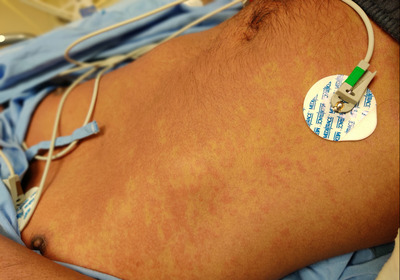1. PATIENT PRESENTATION
A previously healthy 24‐year‐old male of East Asian descent presented with fever, diffuse body rash, and non‐purulent conjunctivitis 20 days after recovering from a confirmed coronavirus disease of 2019 (COVID‐19) infection. His vital signs revealed a pulse of 120 beats/minute, blood pressure 86/65 mmHg, respiratory rate 18/minute, axillary temperature 39.1°C (102.4°F), and oxygen saturation 98% on room air. Physical examination showed a palm‐sparing blanching maculopapular rash (Figure 1). He demonstrated bilateral non‐purulent conjunctivitis (Figure 2). In the emergency department, abnormal laboratory results included an elevated erythrocyte sedimentation rate of 103 mm/hour (2‐15) and a C‐reactive protein of 230 mg/L (< 5), a ferritin rate of 893 ug/L (20‐300), a high‐sensitive troponin (hsTrop) rate of 7830 ng/L (< 4), and a brain natriuretic peptide level of 220 ng/L (< 100). Chest radiograph and ECG were normal.
FIGURE 1.

Pan‐corporeal blanching maculopapular rash, sparing the palms
FIGURE 2.

Bilateral non‐purulent conjunctivitis
2. DIAGNOSIS
2.1. Multisystem inflammatory syndrome in adults (MIS‐A) associated with recent severe acute respiratory syndrome coronavirus 2 infection (SARS‐CoV‐2)
MIS‐A after COVID‐19 is a postinfectious inflammatory syndrome that tends to present several weeks after recovering from COVID‐19 infection. 1 , 2 , 3 MIS‐A, although poorly understood, is characterized by fever, markedly elevated inflammatory biomarkers, and multiple organ system involvement. Cardiac injury and shock are common, with elevated cardiac biomarkers, left ventricular dysfunction, coronary dilatation, and a requirement for vasopressor or inotrope support. 1 , 2
The findings of a negative SARS‐CoV‐2 RT‐PCR test, positive antibody test, and a preceding epidemiologic link to COVID‐19 cases or previous symptoms of COVID‐19 in the setting of a suggestive clinical history and presentation may be helpful for diagnosis. 1 , 2 Intravenous immunoglobulin, steroids, and the interleukin‐6 inhibitor tocilizumab have been used to treat suspected MIS‐A cases, with clinical improvement noted in some instances. 2 , 3 In our case, the patient was admitted to cardiology, his hsTrop declined, his transthoracic echocardiogram revealed mildly diminished left ventricular function (40%), and after consultation with the rheumatology service and a review with a pediatric rheumatologist from our regional referral center, the treating team initiated pulsed‐dose steroids and a course of intravenous immunoglobulin. After a 5‐day admission and improvement in his hemodynamics, rash, and conjunctivitis, the patient was discharged with a tapered course of prednisone.
Ben‐Yakov M, James V. Young man with a diffuse rash and red eyes after recovery from COVID‐2019. JACEP Open. 2021;2:e12404. 10.1002/emp2.12404
Funding and support: By JACEP Open policy, all authors are required to disclose any and all commercial, financial, and other relationships in any way related to the subject of this article as per ICMJE conflict of interest guidelines (see www.icmje.org). The authors have stated that no such relationships exist.
REFERENCES
- 1. Tenforde MW, Morris SB. Multisystem inflammatory syndrome in adults: coming into focus. Chest. 2020;159(2):471‐472. [DOI] [PMC free article] [PubMed] [Google Scholar]
- 2. Hékimian G, Kerneis M, Zeitouni M, et al. Coronavirus disease 2019 acute myocarditis and multisystem inflammatory syndrome in adult intensive and cardiac care units. Chest. 2020;159(2):657‐662. [DOI] [PMC free article] [PubMed] [Google Scholar]
- 3. Morris SB, Schwartz NG, Patel P, et al. Case series of multisystem inflammatory syndrome in adults associated with SARS‐CoV‐2 infection ‐ United Kingdom and United States, March‐August 2020. MMWR Morb Mortal Wkly Rep. 2020;69(40):1450‐1456. [DOI] [PMC free article] [PubMed] [Google Scholar]


